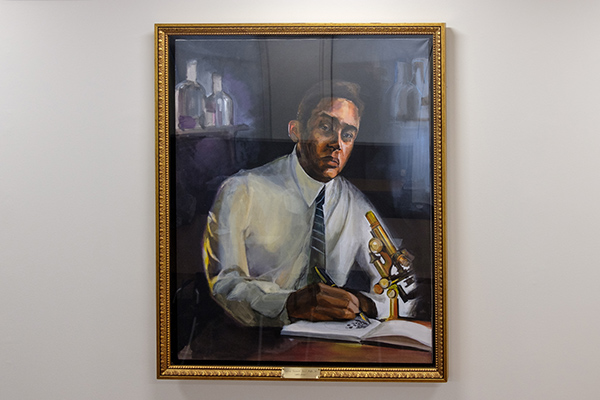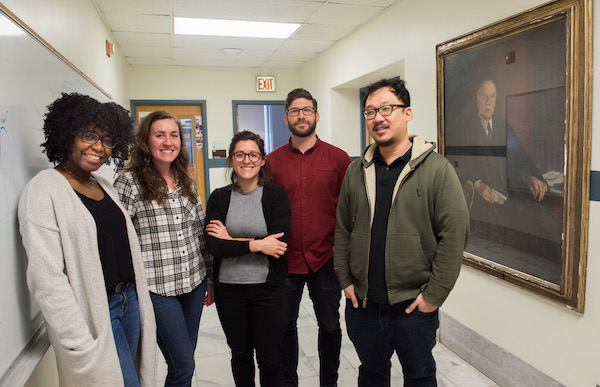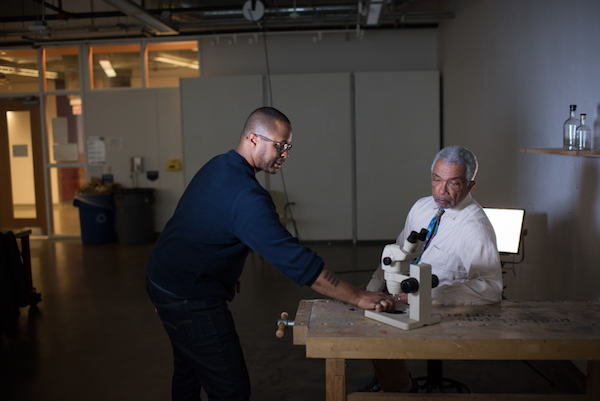Just tribute: Honoring the legacy of pioneering biologist Ernest Everett Just, PhD 1916

Editor's note, Feb. 2019: The portrait of E.E. Just is now complete and hanging in Erman Hall on the UChicago campus
Ernest Everett Just, PhD, spent only three academic quarters on the University of Chicago campus. A professor at Howard University and a research assistant at the Marine Biological Laboratory in Woods Hole, Massachusetts, he was pursuing his PhD in zoology in absentia and needed to fulfill the residency requirement.
Despite his brief physical presence on campus, the research he conducted for his dissertation on the fertilization of marine worms – including a key discovery about cell cleavage – made a lasting contribution to the body of knowledge in embryology.
More than 100 years later, a group of Biological Sciences Division (BSD) graduate students formed the E.E. Just Working Group to promote his achievements and legacy, including the challenges Just faced as an African American scientist in the early 20th century.
Their work builds upon two other BSD initiatives to honor Just’s legacy. The annual E.E. Just lecture, sponsored by the BSD graduate Diversity Committee (BDC) and the Office of Graduate Affairs, brings distinguished scientists from underrepresented groups to campus. This past year, through the efforts of the BDC, especially previous co-chair Carolyn Johnson, PhD, of the Committee on Evolutionary Biology; Victoria Prince, PhD, dean and director of the Office of Graduate Affairs; and Joy Bergelson, PhD, chair of the Department of Ecology and Evolution, a second-floor lecture room in the Erman Biology Center was renovated and dedicated to Just on April 18. Kenneth R. Manning, author of the definitive biography, Black Apollo of Science: The Life of Ernest Everett Just (Oxford University Press, 1983), was the 2018 E.E. Just Lecturer.

For their focus, the students sought a more visually impressive way to commemorate Just beyond the simple wall plaque planned for the E.E. Just Room. A similar room – on the second floor of the adjoining Zoology Building – features a dramatic portrait of Just’s mentor, Frank Lillie, PhD, the renowned director of the Marine Biological Laboratory in Woods Hole, Massachusetts, and the first dean of biological sciences at the University of Chicago.
“We thought that a portrait would be an appropriate and necessary way to commemorate Just and his significant and lasting contributions to his field,” said Shane DuBay, a graduate student in evolutionary biology. “It would be a visual memorial for a prominent black scientist, when images like these are often lacking.”
Daniela Palmer, also pursuing a PhD in evolutionary biology, was instrumental in helping to secure initial funding for the portrait, which is being provided by the BSD Office of Diversity and Inclusion and the Campus-Wide Inclusive Climate Initiative. Fund raising to support the portrait project and the annual EE Just lecture in future years is ongoing.
Palmer said it’s important to bring attention to Just’s story – both the achievements and the difficulties he faced in his career, including racism, lack of financial support for his research and disagreements with other prominent scientists. “The struggles that people face are part of the experience of being a scientist,” Palmer said. “The story is not always this perfect arc of a hero.”

Graduate student Victoria Flores, also in evolutionary biology, emphasized the personal relevance and power of including Just’s image among the historical portraits and photographs of prominent – and mostly white male – University scientists and scholars. “Just is one of those people who could provide that image,” added Sophia Carryl, a graduate student in evolutionary biology, “that figure where you can say, ‘look there’s someone like me, and if he could do it, I can do it as well.’”
The working group, in collaboration with the Multicultural Graduate Community, commissioned artist Stephen Flemister to create the portrait. Flemister recently served as artist-in-residence with the University’s Center for the Study of Race, Politics and Culture, and now teaches in the Department of Contemporary Practices at the School of the Art Institute, where he earned his master of fine arts degree. Flemister’s artwork has been exhibited at the Hyde Park Art Center, Columbia College Chicago, South Side Community Art Center and the University’s Arts Incubator, with public installations and performances throughout Chicago.
While he is known for incorporating multimedia and technology into his works, as well as for his innovative use of more traditional media, Flemister said he is taking a more conventional approach in his depiction of Just. In order to capture variations in postures and form for the portrait, he took a series of photographs of the model, Patric McCoy, a University of Chicago graduate, to use as he makes digital alterations, drawings and sketches to find parallels between the model and Just. For the final work, he will be producing an acrylic and oil painting in the likeness of Just.
The students said that they were impressed with Flemister’s signature use of color to convey depth and emotion in his portraits. Palmer also appreciated his academic interests in art, along with “his ideas about how to represent a person fully.”
“The portrait had to fit in but also stand out, and Steve’s work has this stand-out character that can bring the project to life,” she said.

Flemister, whose master’s thesis addressed the “shared public image in memory and the problems of representation,” is exploring beyond the visual aspects of the project to unearth aspects of icons, memory and recognition within the subject. In addition to researching general portrait styles and postures from the National Portrait Gallery’s Regency collection, Flemister studied Just’s history and legacy. He read the Manning biography and also interviewed McCoy to gain a better appreciation for the experience of a contemporary African American scientist.
Like the students who commissioned him, Flemister hopes that the portrait will stimulate interest in Just’s story and operate as a tool of representation. He is documenting his work on the project through photographs and blog posts highlighting his research.
“I’m looking at how far we can push certain ideas past this figurative, realistic painting,” he said, “and ask, ‘Can we generate questions that introduce a new conversation?’”

